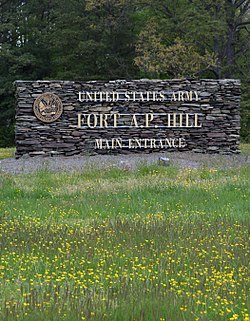Fort A.P. Hill
| Fort A.P. Hill | |
|---|---|
| Caroline County, Virginia | |

Photo of the U.S. Army Garrison Fort A.P. Hill front sign on Route 301, in Virginia in the spring.
|
|
|
Location of Fort A.P. Hill
|
|
| Coordinates | 38°07′04″N 77°16′35″W / 38.11778°N 77.27639°WCoordinates: 38°07′04″N 77°16′35″W / 38.11778°N 77.27639°W |
| Type | Military base |
| Site information | |
| Controlled by |
|
| Website | www |
| Site history | |
| Built | June 11, 1941 |
| In use | 1941—present |
| Garrison information | |
| Current commander |
Lieutenant Colonel Andrew Q. Jordan |
| Past commanders |
Lieutenant Colonel David A. Meyer Lieutenant Colonel Peter E. Dargle Lieutenant Colonel John W. Haefner Lieutenant Colonel Michael S. Graese Lieutenant Colonel James M. Mis Lieutenant Colonel James B. Balocki |
Fort A.P. Hill is a training and maneuver center belonging to the United States Army located near the town of Bowling Green, Virginia. The center focuses on arms training and is used by all branches of the US Armed Forces. It is named for Virginia native and Confederate Lieutenant General A. P. Hill.
In the spring of 1940, the War Plans Division of the Army General Staff developed a plan to raise a national army of four million men that would allow it to conduct simultaneous operations in both the Pacific and Europe theaters. In July 1940, a movement began to locate an area of approximately 60,000 acres (240 km2), independent of any post, and lying somewhere between the Potomac River and the upper Chesapeake Bay.
Lieutenant Colonel Oliver Marston, an artillery officer stationed in Richmond, Virginia and acting as an agent of the Third Corps Area commander, made a detailed investigation of the Bowling Green, Virginia area in September 1940. He enthusiastically recommended that the War Department procure the Caroline County site. The result was a maneuver area that contained 77,332 acres (312.95 km2) and billeting space for 74 officers and 858 enlisted personnel.
Fort A.P. Hill was established as an army training facility on June 11, 1941, pursuant to War Department General Order No. 5. In its first year, the installation was used as a maneuver area for the II Corps and for three activated National Guard divisions from Mid-Atlantic states. In the autumn of 1942, Fort A.P. Hill was the staging area for the headquarters and corps troops of Major General George S. Patton’s Task Force A, which was part of the Western Task Force of the Allied invasion of French North Africa. During the early years of World War II, the post continued to be a training site for corps and division-sized units. Commencing in 1944, field training for Officer Candidate School and enlisted replacements from nearby Forts Lee, Eustis, and Belvoir was conducted.
...
Wikipedia

